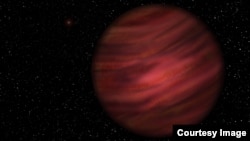Astronomers have discovered the largest solar system found so far.
A team of American, British and Australian astronomers says a planet known as 2MASS J212, once thought to be a “free-floating” or “lonely" planet, is actually in orbit about 1 trillion kilometers from its star.
That is about 7,000 times farther than the Earth is from the sun, and 140 times larger than the orbit of dwarf planet Pluto.
"The planet is not quite as lonely as we first thought, but it's certainly in a very long-distance relationship," said lead author Niall Deacon of the University of Hertfordshire in England.
At that distance, the planet orbits its star about once every 900,000 years, according to the astronomers.
While it’s highly doubtful the planet hosts life, if it did, the residents would see their sun as just a “bright star” and “might not even imagine they were connected to it at all,” Deacon said.
First impression
2MASS J2126 was found eight years ago by U.S. researchers in an infrared sky survey, which caused them to classify it as young and likely of a relatively low mass.
Later, Canadian researchers discovered the planet was “a possible member of a 45 million-year-old group of stars and brown dwarfs known as the Tucana Horologium Association.”
With this information, the astronomers were able to calculate that the planet had a mass of between 12 and 15 times that of Jupiter.
“This is the widest planet system found so far, and both the members of it have been known for eight years,” Deacon said. “But nobody had made the link between the objects before.”
While 2MASS J212 is not a lonely planet, several have been found in recent years. Most of them are gas giants like Jupiter that are just not massive enough to have ignited into shiny stars.
The paper appears in the journal Monthly Notices of the Royal Astronomical Society.









